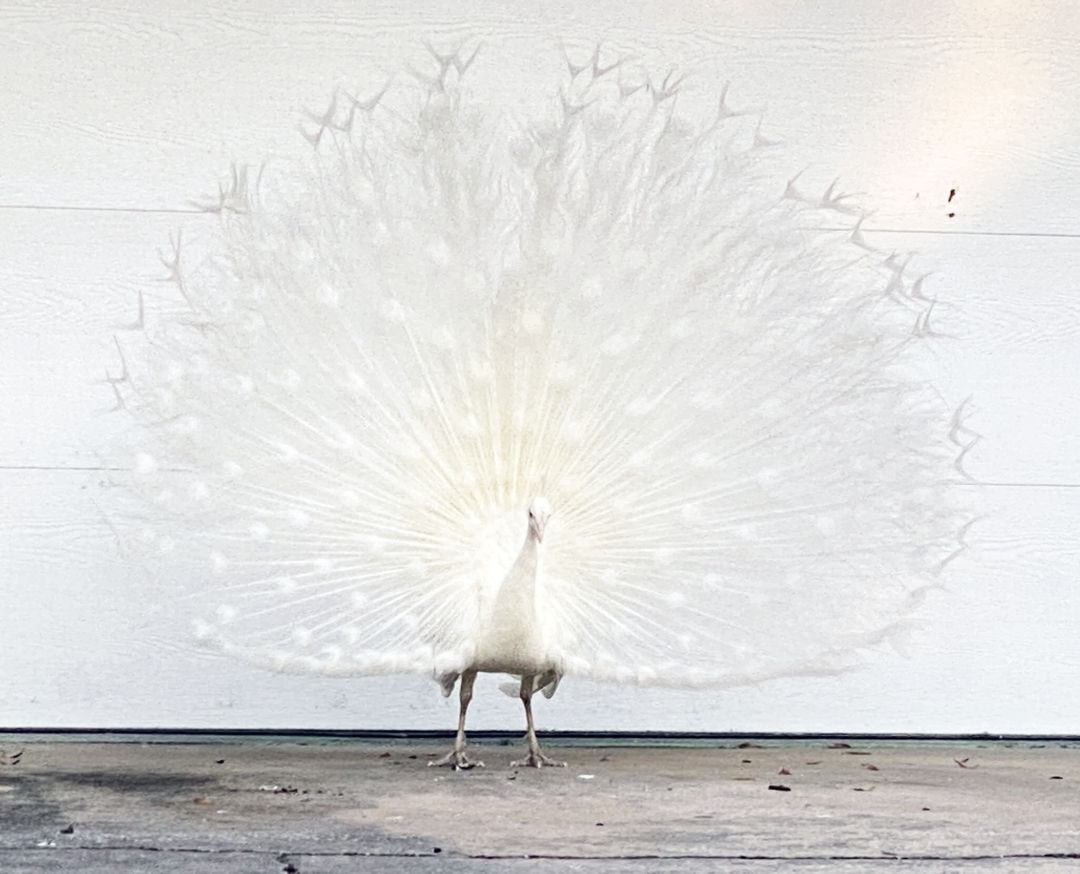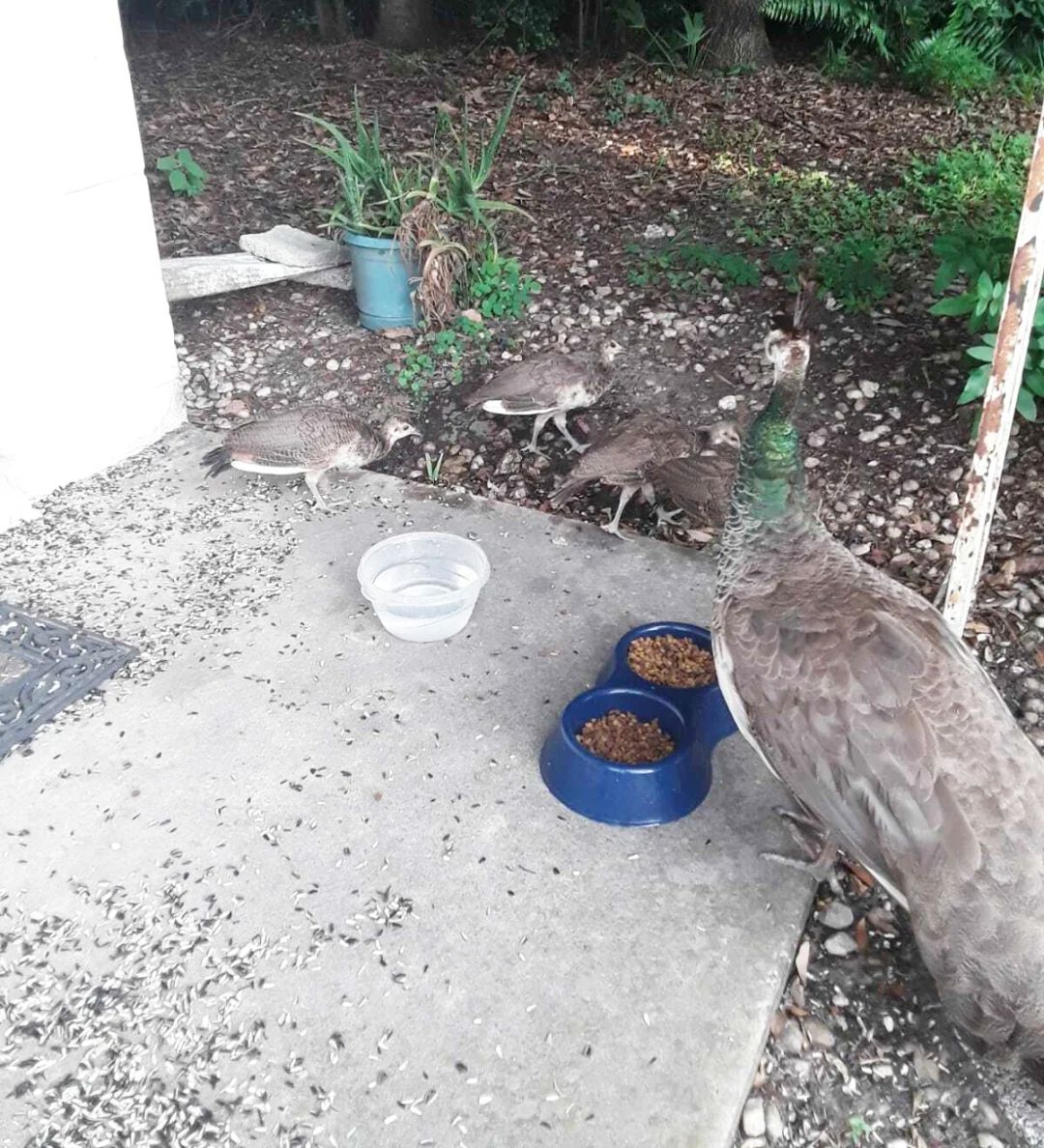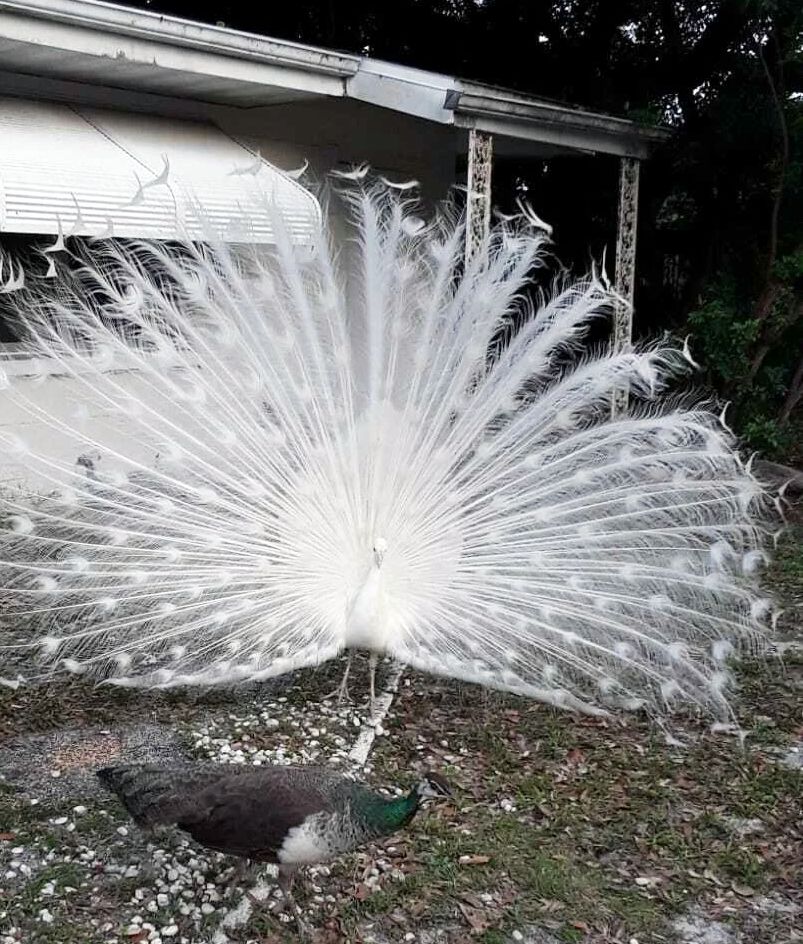Peacocks Prance Through This Historic Sarasota Neighborhood

A white, or leucistic, peacock poses in Indian Beach-Sapphire Shores.
Image: Kim Doleatto
In urban neighborhoods, you expect to share real estate with squirrels, crows, maybe a raccoon or a community cat on its eighth life.
But in Indian Beach-Sapphire Shores just north of downtown Sarasota and west of Tamiami Trail, you might diversify that pool with peafowl (males are peacocks, females peahens, and a group is referred to as a pride).
Area residents say roughly 20 or so peafowl hang out mostly on Bay Shore Road, on top of cars, pecking at lawns and sometimes perched in trees. Their arresting color and unexpected location turn passersby into instant tourists as they slow down and pull out their phones for a picture.
How could you blame them? Shimmering blue and green, it’s only natural that the world’s most impressive members of the avian family would attract paparazzi.
Catalina Schlueb, who lives on Bay Shore Road, doesn’t mind. She's often asked if she owns the pride because she feeds them. She doesn't, but she moved into the neighborhood nine years ago and says she enjoys them since they’re illegal to own in her native Colombia. While there, she often saw their distinctive feathers dangling from earrings, but never the whole bird, she says.
The peafowl visit Schlueb twice a day to eat, between 8 and 10 a.m. and from 5 to 7 p.m., she says. They steal her cat food, but they'll eat almost anything, including cereal, nuts and bread.

Peafowl chicks on Schlueb’s front lawn.
Image: Catalina Schlueb
Schlueb figures them on her grocery list now and has come to know them. Last year, one had chicks, which she noted, made them more cautious. The birds always come close, but she never hand feeds them; instead, she sets the food down for them to eat when they want. They don’t like the look of her cats in the window and cock their heads when she makes a sound in the house. She also notes the females, which are browner in color, push the males around and make sure they're first in line to eat.
“I'm not sure how other neighbors feel about them,” she says, "but the ones across the street feed them too."
However breathtaking they are, the birds are also “prodigious poopers,” says Beth Price, a local bird photographer and avian aficionado. Plus, “introduced species aren't always popular within the birding community," she adds. "And in neighborhoods, they can be noisy."
Aaron Virgin, CEO of Save our Seabirds, describes the peafowl call as a "screeching horn sound.” He would know, since the organization has one on-site. Her name is Doodad and she enjoys insects, fruits and grains. Save Our Seabirds is one of the largest bird rescue centers in Florida, and Virgin says they may get one or two calls a month about peafowls since they sometimes get hit by cars because they're either trying to cross the road, or they're on the edge of the road eating gravel or pebbles to break down hard grains they eat like corn (a normal mode of eating for some birds, he explains). "Other times, they may get attacked by dogs,” he adds.
With the males’ iridescent blue chests and signature fanned tail feather displays, the peafowl are the most stunning of lawn ornaments. And as if those eye-catching colors weren’t enough, with this pride, in particular, a white one stands out of the crowd.

A white peacock on Bay Shore Road in Sarasota.
Image: Catalina Schlueb
Price says the white ones are leucistic—a condition that affects the birds' feathers and turns them pale or white. Leucism differs from albinism in that this variety of peafowl has blue-tinted eyes and lacks normal pigmentation, rather than no pigmentation in the eyes or feathers.
But pet or pest, how did this bird—which is not native to Florida—end up in an urban neighborhood?
They were first kept by maharajas in India as symbols of grace and wealth. In the Middle Ages, European royalty both raised them and ate them, and early Christians used them in art as symbols of immortality.
A popular theory in Indian Beach-Sapphire Shores is that they perhaps one day escaped from nearby Sarasota Jungle Gardens, which has been in the neighborhood since 1939. Although peafowl aren’t on the current roster, a historic advertisement for Jungle Gardens features an illustration of a peacock by a pond.
While it would make sense, “they did not originate from Sarasota Jungle Gardens," Nancy Lavick, director of marketing for Jungle Gardens says. "The peacocks at Jungle Gardens come and go as they please, similarly to how ibis or squirrels do. We have never had a peacock exhibit. They fly over our fences regularly. Many people assume they are ours, but they aren't.”
Indeed, they could have originated from just about anywhere, since people sometimes keep them as pets and eventually let them free. “It happens across the country,” says Virgin. If the weather is temperate, as it is in Sarasota, they do fine.
But Virgin advises against raising and releasing animals because it leaves them with an imprint–a term used by experts to define birds who aren't independent due to human interaction and can’t find food for themselves. “They don't come when you whistle, but they're imprinted so they don't have a fear of humans or view themselves as a wild bird,” he says.
Virgin points out that if they started to breed and increase robustly, that might be a problem since it could lead to friction with sandhill cranes or turkeys.
On Longboat Key, the pest perspective on peafowl won over that of pretty pet, and the town approved spending $25,000 to cage and remove them from the barrier island where the noise, the damage to expensive cars and the traffic from gawkers frustrated residents.
In historic Indian Beach-Sapphire Shores, though—at least for now—they're a mainstay.



